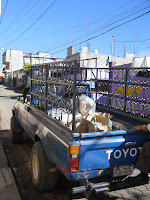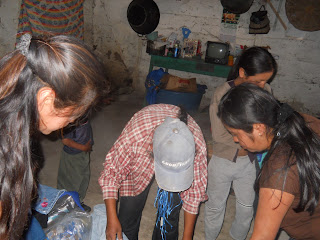This week we teamed up with the grassroots organisation ‘Mujeres
Trabajan Unidas’(MTU) (Women Work Together)! With three members of their team:
Judith the co-ordinator; Samai and Alejandra the assistants; Gem; Kystal from
Community Enterprise Solutions and me...the six of us lived up to the name! With their local
knowledge and our ever growing pot of funds we were able to reach several small
communities that have not yet received any assistance or attention.
With all the governmental and international aid being
directed to the populated centres of San Marcos and San Pedro towns, our aim
has always been to target the forgotten places, the communities where there are
not enough families for it to be ‘viable’ for larger agencies to reach or that simply
are not yet known of. As we travel to
more sites the extent and severity of the problem becomes increasingly apparent.
The following article
describes the situation particularly well and is really worth a read if you are interested...this is widespread,
not only in the department of San Marcos but all of the 8 affected departments
from the highlands to the coastal regions of Guatemala.
They are involved
in three main projects: Las Hermanitas (Little Sisters); La Vida de mi Mama (My
Mother’s Life Story) and Hora de Lectura Familiar (Family Reading Hour). All of
these are designed to promote education, encouraging girls to stay in school,
enforce the family bond and develop the value of literacy.
MTU works with mothers and daughters in 15 rural areas of
San Pedro, these are shown by the map below. These areas are largely indigenous
communities where daughters are needed to either work in the fields or stay and
help at home. Following the earthquake, the small aldeas and caserios (villages
and hamlets) of the San Pedro area, like so many, did not escape the destruction.
Before we arrived an assessment had
already been carried out of the homes in each of the places they work. This
detailed the number of members in the family, what the extent of the damage was
and where help was needed the most. This level of organisation fills us with confidence!
 |
| A serious amount of corn |
Monday morning was
dedicated to a slightly different variety of retail therapy; we split into teams of two and headed off to get price
comparisons on corn, beans, rice, powdered milk, sugar, oats and oil. This is
not the most enjoyable part of the process, but at least with a local doing the
bargaining it took off the pressure of trying not to get ripped off. Usually the
market vendors immediately start seeing pound (or quetzal) signs as soon as a
young female foreigner walks up to the stall.
Monday afternoon was dedicated to bagging. The big sacks of corn,
rice, beans and oats were weighed and divided up into smaller bags. With the
office turned into a store cupboard and Judith arranging transport for the next
morning we headed back to Xela for the night.
 |
| Packing the bags! |
 |
| Team Yellow Pick-up with Judith and our Driver |
 |
| Team Blue Pick-up |
Gem and co headed up north to a caserio called Santa Teresa
(shown on the map in top right corner).
 |
| Three out of nine daughters in this family, hopefully this food and water will help a little bit. |
I headed further south to an Aldea called Corral Grande and another
small community called Chim. Again we were off-road for the majority of the
journey. This is a beautiful part of Guatemala with amazing views, such a
stark contrast to arriving at the communities and seeing the destruction and heaps of rubble.
In Corral Grande we went to each family individually,
meeting many of the girls that the organisation works with. Here we gave 8
families enough food to last at least a few weeks if not more.
On the left is Maritza
Lisbeth Valdez Godínez, who lived with her mum and dad in Corral Grande. After her house was rendered uninhabitable they had to move to live with relatives. The house has now had to be completely demolished (below). The problem is finding the money for re-construction which takes away from the amount available for food and other provisions.
 |
| Maritza's House |
Chim was a very small community with only two or three
families here. These were the kindest and most welcoming people I have yet to
meet on our trips ( I realise this keeps happening each time!). We dropped off bags of food and clothes, some of the girls
had a field day at this point, rummaging through the bags to see what new
things they could find!
 One of the families invited us to eat lunch, we
said no, not wanting to take up precious supplies, but they plated up some
rice, guacamole and tortillas and told us to sit down and eat all the same! The
generosity was amazing; they even gave us some avocados to take home. These are
people with next to nothing with their homes crumbling around them and yet the
hospitality was unlike anything I have ever experienced and I continue to feel privileged.
One of the families invited us to eat lunch, we
said no, not wanting to take up precious supplies, but they plated up some
rice, guacamole and tortillas and told us to sit down and eat all the same! The
generosity was amazing; they even gave us some avocados to take home. These are
people with next to nothing with their homes crumbling around them and yet the
hospitality was unlike anything I have ever experienced and I continue to feel privileged.
As of today (30th November 2012) we have reached a total of £1356.30 so thanks to everyone! We are so
close to our target of £1500, please help us get there! I know December isn’t
the best month to be asking but even a fiver goes such a long way here. The next one is likely to be our last bulk buy, so we want to make it as big as
possible! After that I promise to shush!
For all the photos so far:
For one very last time here is my fundraising link, just one
little click! http://www.justgiving.com/guatemalaearthquakeappeal














































